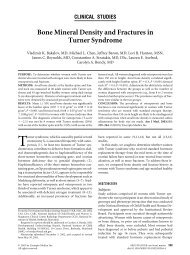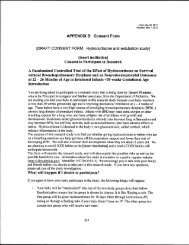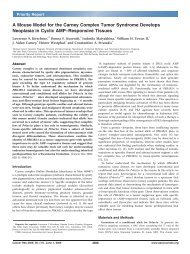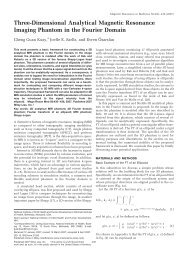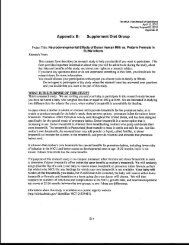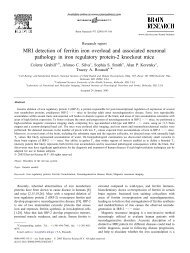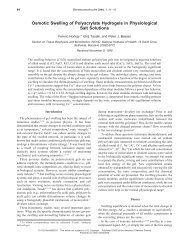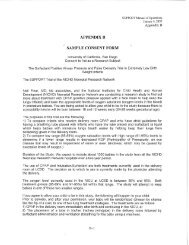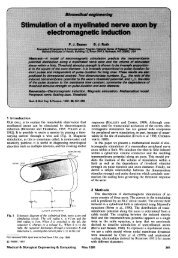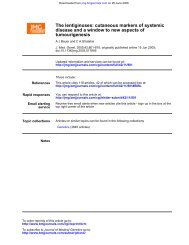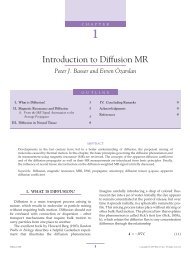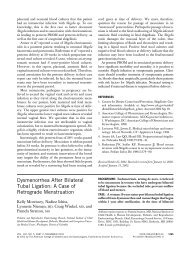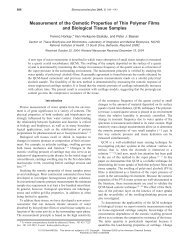Comparison between the effect of calcium ions on the osmotic ...
Comparison between the effect of calcium ions on the osmotic ...
Comparison between the effect of calcium ions on the osmotic ...
Create successful ePaper yourself
Turn your PDF publications into a flip-book with our unique Google optimized e-Paper software.
COMPARISON BETWEEN THE EFFECT OF CALCIUM IONS ONTHE OSMOTIC PROPERTIES OF SYNTHETIC AND BIOPOLYMER GELS Ferenc Horkay 1 , Peter J. Basser 1 , Anne-Marie Hecht 2 and Erik Geissler 2where ν is <str<strong>on</strong>g>the</str<strong>on</strong>g> c<strong>on</strong>centrati<strong>on</strong> <str<strong>on</strong>g>of</str<strong>on</strong>g> <str<strong>on</strong>g>the</str<strong>on</strong>g> elastic chains in <str<strong>on</strong>g>the</str<strong>on</strong>g> network, ϕ is <str<strong>on</strong>g>the</str<strong>on</strong>g>volume fracti<strong>on</strong> <str<strong>on</strong>g>of</str<strong>on</strong>g> <str<strong>on</strong>g>the</str<strong>on</strong>g> polymer, R is <str<strong>on</strong>g>the</str<strong>on</strong>g> gas c<strong>on</strong>stant, T is <str<strong>on</strong>g>the</str<strong>on</strong>g> absolutetemperature, and A is a c<strong>on</strong>stant that depends <strong>on</strong> <str<strong>on</strong>g>the</str<strong>on</strong>g> functi<strong>on</strong>ality <str<strong>on</strong>g>of</str<strong>on</strong>g> <str<strong>on</strong>g>the</str<strong>on</strong>g> crosslinks.1 Secti<strong>on</strong> <strong>on</strong> Tissue Biophysics and Biomimetics, Laboratory <str<strong>on</strong>g>of</str<strong>on</strong>g> Integrative andMedical Biophysics, NICHD, Nati<strong>on</strong>al Institutes <str<strong>on</strong>g>of</str<strong>on</strong>g> Health, 13 South Drive,Be<str<strong>on</strong>g>the</str<strong>on</strong>g>sda, MD 208922 Laboratoire de Spectrométrie Physique CNRS UMR 5588, Université JosephFourier de Grenoble, B.P.87, 38402 St Martin d’Hères, France.12010080DNASPAIntroducti<strong>on</strong>Gels are particularly suitable to study i<strong>on</strong>-polymer interact<str<strong>on</strong>g>i<strong>on</strong>s</str<strong>on</strong>g>.M<strong>on</strong>ovalent-divalent cati<strong>on</strong>-exchange plays central role in variousphysiological processes such as nerve excitati<strong>on</strong> and muscle c<strong>on</strong>tracti<strong>on</strong> It isnatural to use syn<str<strong>on</strong>g>the</str<strong>on</strong>g>tic polyelectrolyte gels as model systems to dem<strong>on</strong>strateprinciples, develop and verify new experimental approaches. 1,2 They arerelatively easy to make, <str<strong>on</strong>g>the</str<strong>on</strong>g>ir structure can be well-c<strong>on</strong>trolled, and <str<strong>on</strong>g>the</str<strong>on</strong>g>y aresensitive to different external stimuli such as temperature, solventcompositi<strong>on</strong>, and pH. However, previous studies <strong>on</strong> syn<str<strong>on</strong>g>the</str<strong>on</strong>g>tic polyelectrolytegels were not performed in c<strong>on</strong>dit<str<strong>on</strong>g>i<strong>on</strong>s</str<strong>on</strong>g> that are biologically relevant. In thiswork we compare experimental findings obtained by macroscopic <strong>osmotic</strong> andmechanical measurements, and small angle neutr<strong>on</strong> scattering for weaklycross-linked sodium polyacrylate gels (SPA) and DNA gels. These gels swellin physiological salt soluti<strong>on</strong> and exhibit a reversible volume transiti<strong>on</strong> when<str<strong>on</strong>g>calcium</str<strong>on</strong>g> <str<strong>on</strong>g>i<strong>on</strong>s</str<strong>on</strong>g> are added. 3,4ExperimentalSPA gels were made by free-radical polymerizati<strong>on</strong> at 30% (w/w)acrylic acid m<strong>on</strong>omer c<strong>on</strong>centrati<strong>on</strong> in <str<strong>on</strong>g>the</str<strong>on</strong>g> presence <str<strong>on</strong>g>of</str<strong>on</strong>g> 0.3% N,N'methylenebis(acrylamide) cross-linker as described previously. 3 After gelati<strong>on</strong><str<strong>on</strong>g>the</str<strong>on</strong>g> remaining acrylic acid units were neutralized by NaOH.DNA gels were made from deoxyrib<strong>on</strong>ucleic acid sodium salt (Sigma).The molecular weight determined by ultracentrifugati<strong>on</strong> was 1.3x10 6 Da. DNA gels were prepared 4 from a 3% (w/w) soluti<strong>on</strong> by cross-linking with ethyleneglycol diglycidyl e<str<strong>on</strong>g>the</str<strong>on</strong>g>r at pH = 9.0 using TEMED to adjust <str<strong>on</strong>g>the</str<strong>on</strong>g> pH.Both SPA and DNA gels were swollen in 40 mM NaCl soluti<strong>on</strong>, and<str<strong>on</strong>g>the</str<strong>on</strong>g>n <str<strong>on</strong>g>the</str<strong>on</strong>g> c<strong>on</strong>centrati<strong>on</strong> <str<strong>on</strong>g>of</str<strong>on</strong>g> CaCl 2 in <str<strong>on</strong>g>the</str<strong>on</strong>g> surrounding NaCl soluti<strong>on</strong> wasgradually increased up to 2.0 mM.Swelling pressure measurements were made by equilibrating <str<strong>on</strong>g>the</str<strong>on</strong>g> gelswith aqueous solut<str<strong>on</strong>g>i<strong>on</strong>s</str<strong>on</strong>g> <str<strong>on</strong>g>of</str<strong>on</strong>g> poly(vinyl pyrrolid<strong>on</strong>e) (M n = 29 kDa) <str<strong>on</strong>g>of</str<strong>on</strong>g> known<strong>osmotic</strong> pressure. 5,6 The penetrati<strong>on</strong> <str<strong>on</strong>g>of</str<strong>on</strong>g> <str<strong>on</strong>g>the</str<strong>on</strong>g> polymer into <str<strong>on</strong>g>the</str<strong>on</strong>g> swollen networkwas prevented by a semipermeable membrane.Elastic (shear) modulus measurements were carried out <strong>on</strong> cylindricalgel samples using a TA.XT2I HR Texture Analyser (Stable Micro Systems,UK).Small angle neutr<strong>on</strong> scattering (SANS) measurements were made <strong>on</strong> <str<strong>on</strong>g>the</str<strong>on</strong>g>NG3 instrument 7 at <str<strong>on</strong>g>the</str<strong>on</strong>g> Nati<strong>on</strong>al Institute <str<strong>on</strong>g>of</str<strong>on</strong>g> Standards and Technology(NIST), Gai<str<strong>on</strong>g>the</str<strong>on</strong>g>rsburg MD, and <strong>on</strong> <str<strong>on</strong>g>the</str<strong>on</strong>g> D22 instrument at <str<strong>on</strong>g>the</str<strong>on</strong>g> Institut LaueLangevin (Grenoble).All experiments were carried out at 25 ± 0.1°C.Results and Discussi<strong>on</strong>Figure 1 shows <str<strong>on</strong>g>the</str<strong>on</strong>g> dependence <str<strong>on</strong>g>of</str<strong>on</strong>g> <str<strong>on</strong>g>the</str<strong>on</strong>g> swelling degree (1/ϕ) <strong>on</strong> <str<strong>on</strong>g>the</str<strong>on</strong>g>CaCl 2 c<strong>on</strong>centrati<strong>on</strong> for SPA and DNA gels swollen in 40 mM NaCl soluti<strong>on</strong>.With increasing CaCl 2 c<strong>on</strong>centrati<strong>on</strong> both systems display a sudden volumechange. The sharp variati<strong>on</strong> <str<strong>on</strong>g>of</str<strong>on</strong>g> <str<strong>on</strong>g>the</str<strong>on</strong>g> swelling degree indicates that <str<strong>on</strong>g>the</str<strong>on</strong>g> transiti<strong>on</strong>is a cooperative process.In <str<strong>on</strong>g>the</str<strong>on</strong>g> case <str<strong>on</strong>g>of</str<strong>on</strong>g> a polyelectrolyte gel <str<strong>on</strong>g>the</str<strong>on</strong>g> swelling pressure Π sw is given as<str<strong>on</strong>g>the</str<strong>on</strong>g> sum <str<strong>on</strong>g>of</str<strong>on</strong>g> elastic Π el , mixing Π mix and i<strong>on</strong>ic Π i<strong>on</strong> c<strong>on</strong>tribut<str<strong>on</strong>g>i<strong>on</strong>s</str<strong>on</strong>g> 8Π sw = Π el + Π mix + Π i<strong>on</strong> (1)In what follows we investigate <str<strong>on</strong>g>the</str<strong>on</strong>g> <str<strong>on</strong>g>effect</str<strong>on</strong>g> <str<strong>on</strong>g>of</str<strong>on</strong>g> <str<strong>on</strong>g>calcium</str<strong>on</strong>g> <str<strong>on</strong>g>i<strong>on</strong>s</str<strong>on</strong>g> <strong>on</strong> <str<strong>on</strong>g>the</str<strong>on</strong>g> terms <str<strong>on</strong>g>of</str<strong>on</strong>g>eq. (1).The elastic c<strong>on</strong>tributi<strong>on</strong> can be expressed by <str<strong>on</strong>g>the</str<strong>on</strong>g> shear modulus G <str<strong>on</strong>g>of</str<strong>on</strong>g> <str<strong>on</strong>g>the</str<strong>on</strong>g>gel 9 Π el = -G = - ARTν ϕ 1/3 (2)1/ϕ60402000 0.5 1 1.5 2Ca 2+ [mM]Figure 1. Variati<strong>on</strong> <str<strong>on</strong>g>of</str<strong>on</strong>g> <str<strong>on</strong>g>the</str<strong>on</strong>g> swelling degree <str<strong>on</strong>g>of</str<strong>on</strong>g> SPA and DNA gels as afuncti<strong>on</strong> <str<strong>on</strong>g>of</str<strong>on</strong>g> <str<strong>on</strong>g>the</str<strong>on</strong>g> CaCl 2 c<strong>on</strong>centrati<strong>on</strong>. The gels were swollen in 40 mM NaClsoluti<strong>on</strong>.G / kPa5432140 mM NaCl100 mM NaCl40 mM NaCl + 0.2 mM CaCl 240 mM NaCl + 0.5 mM CaCl 240 mM NaCl + 0.8 mM CaCl 200 0.05 0.1 0.15 0.2 0.25 0.3ϕFigure 2a. Dependence <str<strong>on</strong>g>of</str<strong>on</strong>g> <str<strong>on</strong>g>the</str<strong>on</strong>g> shear modulus <str<strong>on</strong>g>of</str<strong>on</strong>g> SPA gels <strong>on</strong> <str<strong>on</strong>g>the</str<strong>on</strong>g> polymervolume fracti<strong>on</strong> in 40 mM NaCl soluti<strong>on</strong> c<strong>on</strong>taining different amounts <str<strong>on</strong>g>of</str<strong>on</strong>g>CaCl 2 .G / kPa2.521.510.540 mM NaCl+0.10 mM CaCl 240 mM NaCl+0.20 mM CaCl 210 mM NaCl40 mM NaCl100 mM NaCl00 0.05 0.1 0.15ϕFigure 2b. Variati<strong>on</strong> <str<strong>on</strong>g>of</str<strong>on</strong>g> <str<strong>on</strong>g>the</str<strong>on</strong>g> shear modulus <str<strong>on</strong>g>of</str<strong>on</strong>g> DNA gels with <str<strong>on</strong>g>the</str<strong>on</strong>g> polymervolume fracti<strong>on</strong> in 40 mM NaCl soluti<strong>on</strong> c<strong>on</strong>taining different amounts <str<strong>on</strong>g>of</str<strong>on</strong>g>CaCl 2 .In Figure 2 <str<strong>on</strong>g>the</str<strong>on</strong>g> <str<strong>on</strong>g>effect</str<strong>on</strong>g> <str<strong>on</strong>g>of</str<strong>on</strong>g> Ca 2+ <str<strong>on</strong>g>i<strong>on</strong>s</str<strong>on</strong>g> <strong>on</strong> <str<strong>on</strong>g>the</str<strong>on</strong>g> shear moduli <str<strong>on</strong>g>of</str<strong>on</strong>g> SPA and DNAgels is compared. In SPA gels G is practically independent <str<strong>on</strong>g>of</str<strong>on</strong>g> <str<strong>on</strong>g>the</str<strong>on</strong>g> CaCl 2c<strong>on</strong>centrati<strong>on</strong> (Figure 2a). This result implies that Ca 2+ <str<strong>on</strong>g>i<strong>on</strong>s</str<strong>on</strong>g> make nosignificant c<strong>on</strong>tributi<strong>on</strong> to <str<strong>on</strong>g>the</str<strong>on</strong>g> cross-link density. In c<strong>on</strong>trast, <str<strong>on</strong>g>the</str<strong>on</strong>g> elasticProceedings Published 2005 by <str<strong>on</strong>g>the</str<strong>on</strong>g> American Chemical Society
properties <str<strong>on</strong>g>of</str<strong>on</strong>g> DNA gels are substantially modified by Ca 2+ <str<strong>on</strong>g>i<strong>on</strong>s</str<strong>on</strong>g> (Figure 2b). Itis likely that Ca 2+ <str<strong>on</strong>g>i<strong>on</strong>s</str<strong>on</strong>g> replace c<strong>on</strong>densed sodium <str<strong>on</strong>g>i<strong>on</strong>s</str<strong>on</strong>g>, and reduce <str<strong>on</strong>g>the</str<strong>on</strong>g>repulsi<strong>on</strong> <str<strong>on</strong>g>between</str<strong>on</strong>g> DNA strands. Molecular associati<strong>on</strong> creates DNA-richdomains separated by reg<str<strong>on</strong>g>i<strong>on</strong>s</str<strong>on</strong>g> <str<strong>on</strong>g>of</str<strong>on</strong>g> diminished DNA c<strong>on</strong>centrati<strong>on</strong>. The elasticmodulus <str<strong>on</strong>g>of</str<strong>on</strong>g> a gel c<strong>on</strong>taining c<strong>on</strong>centrated z<strong>on</strong>es embedded into a s<str<strong>on</strong>g>of</str<strong>on</strong>g>t elasticmatrix is primarily governed by <str<strong>on</strong>g>the</str<strong>on</strong>g> properties <str<strong>on</strong>g>of</str<strong>on</strong>g> <str<strong>on</strong>g>the</str<strong>on</strong>g> matrix. This picture isc<strong>on</strong>sistent with <str<strong>on</strong>g>the</str<strong>on</strong>g> observed decrease <str<strong>on</strong>g>of</str<strong>on</strong>g> G at high swelling degrees in <str<strong>on</strong>g>the</str<strong>on</strong>g>presence <str<strong>on</strong>g>of</str<strong>on</strong>g> Ca 2+ <str<strong>on</strong>g>i<strong>on</strong>s</str<strong>on</strong>g>. At higher DNA c<strong>on</strong>centrati<strong>on</strong>, however, <str<strong>on</strong>g>the</str<strong>on</strong>g> elasticmodulus <str<strong>on</strong>g>of</str<strong>on</strong>g> <str<strong>on</strong>g>the</str<strong>on</strong>g> Ca-c<strong>on</strong>taining gel exceeds that <str<strong>on</strong>g>of</str<strong>on</strong>g> <str<strong>on</strong>g>the</str<strong>on</strong>g> corresp<strong>on</strong>ding Ca-freegel. 4 The mixing c<strong>on</strong>tributi<strong>on</strong> Π mixcan be given by a Flory-type equati<strong>on</strong>-1)I(q) (cm1001010.1DNAΠ = − (RT/v 1 )[ln(1-ϕ) + ϕ + χϕ + χ ϕ ] (3)mixwhere v 1 is <str<strong>on</strong>g>the</str<strong>on</strong>g> molar volume <str<strong>on</strong>g>of</str<strong>on</strong>g> <str<strong>on</strong>g>the</str<strong>on</strong>g> solvent, χ 0and χ 1 are c<strong>on</strong>stants.In Figure 3 is shown <str<strong>on</strong>g>the</str<strong>on</strong>g> variati<strong>on</strong> <str<strong>on</strong>g>of</str<strong>on</strong>g> χ 0and χ 1 with <str<strong>on</strong>g>the</str<strong>on</strong>g> CaCl 2c<strong>on</strong>centrati<strong>on</strong> for SPA and DNA gels. In both systems <str<strong>on</strong>g>the</str<strong>on</strong>g> sec<strong>on</strong>d orderinteracti<strong>on</strong> parameter χ 0 varies weakly with <str<strong>on</strong>g>the</str<strong>on</strong>g> polymer c<strong>on</strong>centrati<strong>on</strong>, while<str<strong>on</strong>g>the</str<strong>on</strong>g> third order interacti<strong>on</strong> parameter χ 1 exhibits a sharp, jump-like increase atlow CaCl 2 c<strong>on</strong>centrati<strong>on</strong>. The variati<strong>on</strong> <str<strong>on</strong>g>of</str<strong>on</strong>g> χ 1 may be related to <str<strong>on</strong>g>the</str<strong>on</strong>g> <str<strong>on</strong>g>effect</str<strong>on</strong>g> <str<strong>on</strong>g>of</str<strong>on</strong>g>Ca 2+ <str<strong>on</strong>g>i<strong>on</strong>s</str<strong>on</strong>g> <strong>on</strong> <str<strong>on</strong>g>the</str<strong>on</strong>g> flexibility <str<strong>on</strong>g>of</str<strong>on</strong>g> <str<strong>on</strong>g>the</str<strong>on</strong>g> polyeletrolyte chains.χ , χ0 10 0.05 0.10 0.15 0.20 0.250.70.60.50.40.30.2DNA gelsχ1(SPA)χ0(SPA)SPA gelsχ1(DNA)χ0(DNA)0.10 0.2 0.4 0.6 0.8 1CaCl / mM2Figure 3. Variati<strong>on</strong> <str<strong>on</strong>g>of</str<strong>on</strong>g> <str<strong>on</strong>g>the</str<strong>on</strong>g> Flory-Huggins interacti<strong>on</strong> parameter as a functi<strong>on</strong><str<strong>on</strong>g>of</str<strong>on</strong>g> <str<strong>on</strong>g>the</str<strong>on</strong>g> CaCl 2 c<strong>on</strong>centrati<strong>on</strong> in DNA gels swollen in 40 mM NaCl soluti<strong>on</strong>.Figure 4 shows <str<strong>on</strong>g>the</str<strong>on</strong>g> neutr<strong>on</strong> scattering intensity I(q) as a functi<strong>on</strong> <str<strong>on</strong>g>of</str<strong>on</strong>g> <str<strong>on</strong>g>the</str<strong>on</strong>g>scattering vector q for SPA and DNA gels. The main features <str<strong>on</strong>g>of</str<strong>on</strong>g> <str<strong>on</strong>g>the</str<strong>on</strong>g> scatteringspectra <str<strong>on</strong>g>of</str<strong>on</strong>g> <str<strong>on</strong>g>the</str<strong>on</strong>g>se gels are similar. At low q a power law behavior is observedcaused by scattering from surfaces. At intermediate q <str<strong>on</strong>g>the</str<strong>on</strong>g> scattering intensityvaries as q -1 . This behavior is typical <str<strong>on</strong>g>of</str<strong>on</strong>g> scattering from rod-like structures.At high q <str<strong>on</strong>g>the</str<strong>on</strong>g> scattering resp<strong>on</strong>se can be described by <str<strong>on</strong>g>the</str<strong>on</strong>g> Ornstein-Zernikeexpressi<strong>on</strong>. The c<strong>on</strong>tinuous curve through <str<strong>on</strong>g>the</str<strong>on</strong>g> SPA data points is <str<strong>on</strong>g>the</str<strong>on</strong>g> leastsquares fit <str<strong>on</strong>g>of</str<strong>on</strong>g> eq. 4 to <str<strong>on</strong>g>the</str<strong>on</strong>g> data 10⎡ 2∆ρ 2 kTϕ 1 1⎤nI(q) = ⎢+ Cϕ ⎥ (4)⎢ ⎣ M (1 + qL) 1+ q2) 2 os ( ξ ⎥⎦0.01slope: -1SPA0.001 0.01 0.1 1q (Å -1 )Figure 4. SANS spectra <str<strong>on</strong>g>of</str<strong>on</strong>g> SPA and DNA gels in 40 mM NaCl soluti<strong>on</strong>c<strong>on</strong>taining 0.1 mM CaCl 2 .C<strong>on</strong>clus<str<strong>on</strong>g>i<strong>on</strong>s</str<strong>on</strong>g>Osmotic and scattering measurements reveal close similarities <str<strong>on</strong>g>between</str<strong>on</strong>g><str<strong>on</strong>g>the</str<strong>on</strong>g> structure and macroscopic <strong>osmotic</strong> properties <str<strong>on</strong>g>of</str<strong>on</strong>g> weakly cross-linked SPAand DNA gels swollen in nearly physiological salt solut<str<strong>on</strong>g>i<strong>on</strong>s</str<strong>on</strong>g>. Additi<strong>on</strong> <str<strong>on</strong>g>of</str<strong>on</strong>g>CaCl 2 induces a reversible volume transiti<strong>on</strong> in both systems. Below <str<strong>on</strong>g>the</str<strong>on</strong>g>transiti<strong>on</strong> <str<strong>on</strong>g>calcium</str<strong>on</strong>g> <str<strong>on</strong>g>i<strong>on</strong>s</str<strong>on</strong>g> produce a sudden increase in <str<strong>on</strong>g>the</str<strong>on</strong>g> third order Flory-Huggins interacti<strong>on</strong> parameter, while <str<strong>on</strong>g>the</str<strong>on</strong>g> sec<strong>on</strong>d order interacti<strong>on</strong> parameter<strong>on</strong>ly weakly increases. SANS measurements indicate that <str<strong>on</strong>g>the</str<strong>on</strong>g> main features <str<strong>on</strong>g>of</str<strong>on</strong>g><str<strong>on</strong>g>the</str<strong>on</strong>g> scattering spectra are identical. Shear modulus measurements revealdifferences <str<strong>on</strong>g>between</str<strong>on</strong>g> <str<strong>on</strong>g>the</str<strong>on</strong>g> elastic properties <str<strong>on</strong>g>of</str<strong>on</strong>g> SPA and DNA gels. The shearmodulus <str<strong>on</strong>g>of</str<strong>on</strong>g> SPA gels is practically independent <str<strong>on</strong>g>of</str<strong>on</strong>g> <str<strong>on</strong>g>the</str<strong>on</strong>g> CaCl 2 c<strong>on</strong>centrati<strong>on</strong> <str<strong>on</strong>g>of</str<strong>on</strong>g><str<strong>on</strong>g>the</str<strong>on</strong>g> surrounding salt soluti<strong>on</strong>. The shear modulus <str<strong>on</strong>g>of</str<strong>on</strong>g> Ca-c<strong>on</strong>taining DNA gelsis smaller at low DNA c<strong>on</strong>centrati<strong>on</strong>, and greater at high DNA c<strong>on</strong>centrati<strong>on</strong>than that <str<strong>on</strong>g>of</str<strong>on</strong>g> <str<strong>on</strong>g>the</str<strong>on</strong>g> corresp<strong>on</strong>ding Ca-free DNA gel.Acknowledgements. The authors acknowledge <str<strong>on</strong>g>the</str<strong>on</strong>g> support <str<strong>on</strong>g>of</str<strong>on</strong>g> <str<strong>on</strong>g>the</str<strong>on</strong>g>Nati<strong>on</strong>al Institute <str<strong>on</strong>g>of</str<strong>on</strong>g> Standards and Technology, U.S. Department <str<strong>on</strong>g>of</str<strong>on</strong>g>Commerce, and <str<strong>on</strong>g>the</str<strong>on</strong>g> Institut Laue-Langevin, Grenoble, France, in providingneutr<strong>on</strong> research facilities used in this experiment. This work is based up<strong>on</strong>activities supported by <str<strong>on</strong>g>the</str<strong>on</strong>g> Nati<strong>on</strong>al Science Foundati<strong>on</strong> under Agreement No.DMR-9423101.References(1) Tasaki, I.; Byrne, P. M.: Biopolymers 1994, 34, 209.(2) Tasaki, I.: Jpn. J. Physiol. 1999, 49, 125(3) Horkay, F.; Tasaki, I.; Basser, P.J.: Biomacromolecules 2000, 1, 84.(4) Horkay, F.; Basser, P.J.: Biomacromolecules 2004, 5, 232.(5) Vink, H. Europ. Polym. J. 1971, 7, 1411.(6) Horkay, F.; Zrinyi,,M.: Macromolecules 1982, 15, 1306.(7) NIST Cold Neutr<strong>on</strong> Research Facility. NG3 and NG7 30-meter SANS(8) Instruments Data Acquisiti<strong>on</strong> Manual, January 1999.(9) Flory, P.J. Principles <str<strong>on</strong>g>of</str<strong>on</strong>g> Polymer Chemistry; Cornell University Press:(10) Ithaca, NY, 1953.(11) Treloar, L.R.G.: The Physics <str<strong>on</strong>g>of</str<strong>on</strong>g> Rubber Elasticity, Clarend<strong>on</strong>, Oxford,(12) 1975.(13) , Horkay, F.; Hecht, A.M.; Grillo, I.; Basser, P.J.; Geissler, E.: J. Chem.(14) Phys. 2002, 117, 9103.where ∆ρ 2 is a c<strong>on</strong>trast factor, k is <str<strong>on</strong>g>the</str<strong>on</strong>g> Boltzmann c<strong>on</strong>stant, ξ and L arecorrelati<strong>on</strong> lengths, q is <str<strong>on</strong>g>the</str<strong>on</strong>g> scattering vector, and C and n are c<strong>on</strong>stants. Thefirst term in eq 4 describes <str<strong>on</strong>g>the</str<strong>on</strong>g> <str<strong>on</strong>g>the</str<strong>on</strong>g>rmal c<strong>on</strong>centrati<strong>on</strong> fluctuat<str<strong>on</strong>g>i<strong>on</strong>s</str<strong>on</strong>g> <str<strong>on</strong>g>the</str<strong>on</strong>g>amplitude <str<strong>on</strong>g>of</str<strong>on</strong>g> which is governed by <str<strong>on</strong>g>the</str<strong>on</strong>g> l<strong>on</strong>gitudinal <strong>osmotic</strong> modulus M os (=ϕ∂ω/∂ϕ+4G/3) <str<strong>on</strong>g>of</str<strong>on</strong>g> <str<strong>on</strong>g>the</str<strong>on</strong>g> gel, while <str<strong>on</strong>g>the</str<strong>on</strong>g> sec<strong>on</strong>d term arises from c<strong>on</strong>centrati<strong>on</strong>fluctuat<str<strong>on</strong>g>i<strong>on</strong>s</str<strong>on</strong>g> frozen-in by <str<strong>on</strong>g>the</str<strong>on</strong>g> cross-links.Proceedings Published 2005 by <str<strong>on</strong>g>the</str<strong>on</strong>g> American Chemical Society



